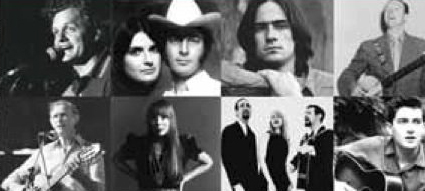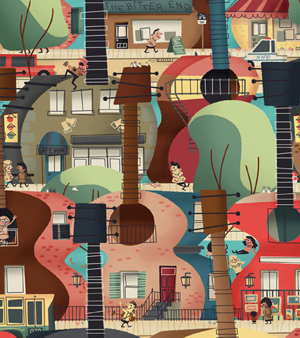
 |
|
|
|
|
With interviews and input from: Pete Seeger, Lucy and Carly Simon, Tom Chapin, Sonny Ochs, Judy Collins, Jose Feliciano, Buffy Sainte-Marie, Ian Tyson, Sylvia Tyson, The Chapin Sisters, Ben Taylor, Israel Horovitz, Oscar Brand, Eddie Brennan, Kris Kristofferson, Pete Fornatale, Terri Thal, Steve Earle, Eric Andersen, John Sebastian, Happy Traum, José Feliciano, Tom Paxton, Paul Colby, Michelle Phillips, John Flynn, Kenny White, Owen Elliot, John Doherty, Tom Bernardin, Doug Yeager, Melanie, Don McLean, Peter Yarrow, Arlo Guthrie, David Amram, Carolyn Hester.

Earlier attempts to catch up by watching compilations of Hootnanny TV shows availed me of nothing -- I quickly learned that singer-songwriters saying anything of merit in the social or political sense were not welcome on that sanitized celebration of folk. Many singers and groups of integrity refused to accept invitations to shows that turned away Pete Seeger. The patron saint Woody Guthrie simply didn't exist in the mainstream commercial culture. Interestingly, I first connected with The Weavers while delivering for a pharmacy in high school -- a disc jockey for an L.A. swing 'n' oldies station played their songs all the time, even though the folk group had been banned in the late 1940s. Like an antibiotic for all this ignorance, the 2012 documentary Greenwich Village: Music that Defined a Generation spells out the story from the '50s to the '70s, related and anecdotalized by the personalities that were there making it happen. Artistic talent originally gravitated to Greenwich Village because rents were (relatively) low; clubs popped up with names like "Cafe Wha?" and artists were able to get plenty of experience performing. Arlo Guthrie explains that he at first did no exhibit a polished talent, but the practice and experience he gained from months of singing to an audience taught him what he needed to know. Another Village habitué remarks that the image of the typical performer was of a penniless troubadour with a guitar slung on his/her back -- instrument cases were for uptown musicians. Part of the delight is of course seeing familiar faces. Lucy and Carly Simon appear together to reminisce, and remember the looseness of the atmosphere where people didn't use booze or drugs, but instead drank coffee. The sisters even sing a bit together. Kris Kristofferson can be a fuzzy witness when talking about other facets of his career, but he's focused and eloquent about his times in The Village. As the father figure to the whole bunch, Pete Seeger is on hand to express the spirit that led into the '60s, and to recount his scrapes with the U.S. Government. It took Seeger a long time to get a potential employer to admit that he had been blacklisted -- the blacklist did not officially exist. 
The censorship apparently came in two waves. The persecution of the early 1950s (Pete Seeger's exact 1955 testimony is given in the book Thirty Years of Treason) was conducted out in the open, relatively speaking. But when politicized federal police entities sought to neutralize so-called subversive influences later in the 1960s, they did it quietly. As Buffy Sainte-Marie explains, they did nothing you could see, but quietly put you out of business. Major folk talent with any interest in protest songs or social comment found that they were famous in Canada, but virtually unknown in the United States. Those episodes are just one aspect of Village history. What we see and hear is joyous enthusiasm for music and for life. Some of the clips show acts clowning when shoehorned into TV formats -- Mama Cass begins a pop music show perf by saying out loud, "Cue the tape, please!" Judy Collins has plenty to say in her interview, and is backed up with vintage clips of her younger self singing beautiful ballads. Melanie is seen in a proto-music video, belting out Lay Down (Candles in the Rain). José Feliciano says some nice things about The Village and then admits that he would make fun of Dylan's voice. He's apparently still making fun of it. 
Many of the interviewees listed above are unfamiliar to civilians like Savant, but I would imagine that folk fans would know them well. The more famous ones do stand out. Peter Yarrow of Peter, Paul and Mary is on camera to offer a number of poignant remarks. Sonny Ochs talks about her younger brother, Phil. Others recount (with the aid of bountiful news film) how the police unilaterally decided to halt singing in Central Park, a tradition that had been going on for over a hundred years. The ban led to protests in the streets. Earlier in 1961, a large group of folk musicians gathered in Washington Square, were judged a riot and assaulted by the police. Some historians put it down as the first Peace Protest incident. Director Laura Archibald keeps things moving, and knows when to give a speaker time to communicate an important point. Helping to organize and unify the story is a narration from the writings of the noted Suze Rotolo, spoken by actress Susan Sarandon. The documentary makes excellent use of amusing, cheerful interstitial animation, in the style of the cover art. It is used with restraint, to help connect the show's content rather than draw undue attention to itself. The Kino Lorber DVD of Greenwich Village: Music that Defined a Generation is a bright and colorful disc with excellent production values. The relaxed and informal new interviews are tastefully shot and carefully lit. The vintage performance sections come from old film, video and kinescopes and look quite good; the audio has been optimized as well. This is not the kind of quickie documentary that offers video clips inferior to what can be found on YouTube. 
A selection of interview outtakes is included for fans that can't get enough of their favorite folk artists. The interview taping reunion seems to have included a sing-along session, and it is included as well. I was of course wishing to see more archival performances, and perhaps complete performances for the (satisfying) clips shown in the docu. I imagine that licensing fees for the bounty of clips were already punishing. I would think that quite a few potential customers -- over-sixty music fans that remember and cherish this era of music -- might be having hearing issues right about now. It's therefore disconcerting that the disc producers couldn't see their way to outfit Greenwich Village with subtitles for the deaf and hearing-impaired. Laws decree that buildings and sidewalks must be accessible to all within reason, so why not videos?
On a scale of Excellent, Good, Fair, and Poor,
Reviews on the Savant main site have additional credits information and are often updated and annotated with reader input and graphics. Also, don't forget the 2011 Savant Wish List. T'was Ever Thus.
Review Staff | About DVD Talk | Newsletter Subscribe | Join DVD Talk Forum |
| |||||||||||||||||